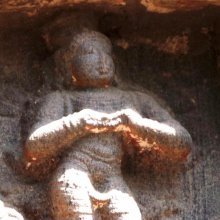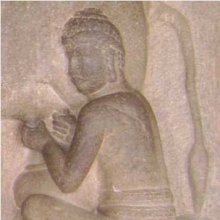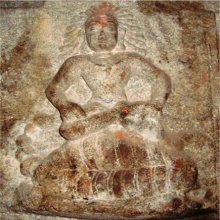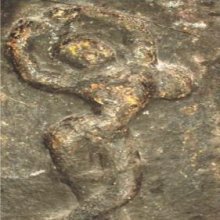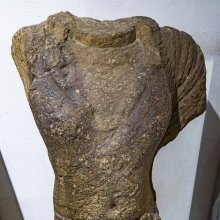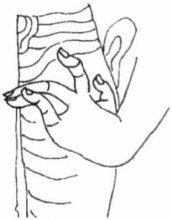Thigh: 2 definitions
Introduction:
Thigh means something in Hinduism, Sanskrit. If you want to know the exact meaning, history, etymology or English translation of this term then check out the descriptions on this page. Add your comment or reference to a book if you want to contribute to this summary article.
Images (photo gallery)
(+52 more images available)
In Hinduism
Shilpashastra (iconography)
Source: Shodhganga: Elements of Art and Architecture in the Trtiyakhanda of the Visnudharmottarapurana (shilpa)The Thighs is denoted by the Sanskrit term Ūru, and represents one of the various body parts whose Measurements should follow the principles of ancient Indian Painting (citra), according to the Viṣṇudharmottarapurāṇa, an ancient Sanskrit text which (being encyclopedic in nature) deals with a variety of cultural topics such as arts, architecture, music, grammar and astronomy.—In the third part of the Viṣṇudharmottarapurāṇa, chapters 35th to 43rd are dedicated to the Painting of different portraits of different kinds of men and women. The measurement of almost all the body parts that should be maintained in a picture have been presented here. For example, the Thigh (ūru) should be 12 aṅgulas.

Shilpashastra (शिल्पशास्त्र, śilpaśāstra) represents the ancient Indian science (shastra) of creative arts (shilpa) such as sculpture, iconography and painting. Closely related to Vastushastra (architecture), they often share the same literature.
Yoga (school of philosophy)
Source: ORA: Amanaska (king of all yogas): A Critical Edition and Annotated Translation by Jason BirchThe Thighs (denoted in Sanskrit as Ūru) are used in the Lotus Pose as part of Yogic exercises, according to the Dattātreyayogaśāstra verse 35-38ab.—Accordingly, while describing the lotus pose (padmāsana): “Having carefully placed the upturned feet on the thighs (ūru) and the upturned hands in between the thighs, [the Yogin] should fix the eyes on the tip of the nose. [...]”.

Yoga is originally considered a branch of Hindu philosophy (astika), but both ancient and modern Yoga combine the physical, mental and spiritual. Yoga teaches various physical techniques also known as āsanas (postures), used for various purposes (eg., meditation, contemplation, relaxation).
See also (Relevant definitions)
Full-text (+673): Uru, Padmasana, Urustambha, Jangha, Uruja, Sakthi, Varoru, Agrajangha, Virasana, Uruglani, Urvashi, Asaktha, Lohitaksha, Ayaskara, Uravya, Urvastha, Uruskambha, Dhenga, Rambhoru, Urunika.
Relevant text
Search found 198 books and stories containing Thigh; (plurals include: Thighs). You can also click to the full overview containing English textual excerpts. Below are direct links for the most relevant articles:
Atharvaveda and Charaka Samhita (by Laxmi Maji)
Ūrustambha (spasticity of thigh) according to Caraka < [Chapter 4 - Diseases and Remedial measures (described in Caraka-saṃhitā)]
Vāta (Vāyu), Pitta and Kapha (Śleṣma) < [Chapter 4 - Diseases and Remedial measures (described in Caraka-saṃhitā)]
Pāṇḍuroga (anemia) according to Caraka < [Chapter 4 - Diseases and Remedial measures (described in Caraka-saṃhitā)]
Trishashti Shalaka Purusha Caritra (by Helen M. Johnson)
Notes on Āsana (postures) < [Notes]
Part 10: Reincarnation of Vasu (fourth of Malli’s six former friends) < [Chapter VI - Śrī Mallināthacaritra]
Part 8: Personal description of Sambhava < [Chapter I - Sambhavajinacaritra]
Dasarupaka (critical study) (by Anuru Ranjan Mishra)
Part 7 - Characters in the Ūrubhaṅga < [Chapter 8 - Utsṛṣṭikāṅka (critical study)]
Part 10 - Application of the Junctures (sandhi) in a Utsṛṣṭikāṅka < [Chapter 8 - Utsṛṣṭikāṅka (critical study)]
Part 2 - Summary of the Ūrubhaṅga < [Chapter 8 - Utsṛṣṭikāṅka (critical study)]
Natyashastra (English) (by Bharata-muni)
The Devi Bhagavata Purana (by Swami Vijñanananda)
Chapter 35 - On the Yoga and Mantra Siddhi < [Book 7]
Chapter 17 - On the continuance of the family of Bhṛgu < [Book 6]
Chapter 3 - On the description of the curse on Gaṅgā, Mahābhiṣa and Vasus < [Book 2]
Garga Samhita (English) (by Danavir Goswami)
Verse 4.12.7 < [Chapter 12 - The Story of the Gopīs That In the Holi Festival Displayed Three Transcendental Virtues]
Verse 4.16.9 < [Chapter 16 - The Srī Yamunā Armor]
Verse 1.14.54 < [Chapter 14 - The Liberation of Śakaṭāsura and Tṛṇāvarta]
Related products
(+4 more products available)
